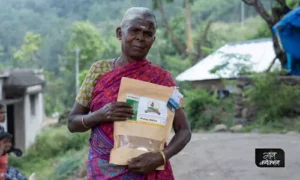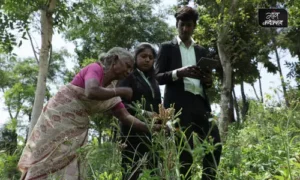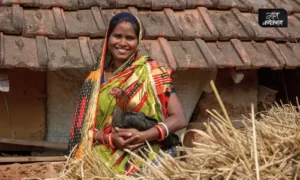Vikrampur (Panna), Madhya Pradesh
It is not yet daybreak, but Radharani Rajgond is already in her field of mahua (Madhuca longifolia) trees, about fifty of them, abutting the jungle. She is not alone as her entire family made up of her husband, Shankar Singh, her son, daughter and daughter-in-law are out in full force picking up the scattered flowers that have formed a yellow carpet beneath the trees.
The fragrance is all-pervasive and the mood of the people gathered there, festive. “It is nothing short of a festival season for us. Our lives depend on the mahua flowers,” a smiling Radharani, told Gaon Connection. But it is a lot of hard work harvesting the flowers, she added.
Radharani’s village Vikrampur in Panna district of Madhya Pradesh is surrounded by forests. There are about 46 families, most of them adivasis who live there, and all are dependent on the mahua.

“We often come to the fields after dinner and climb up to our machchans to spend the night there,” Shankar Singh Rajgond, another villager from Vikrampur, told Gaon Connection. That was to ensure nilgai and wild boars did not come and eat up the fallen mahua flowers, he explained. “Just at the hint of dawn the whole family begins to gather the flowers. We all pitch in but sometimes there are so many flowers to be collected that we can’t gather them all,” he added. The flowers that get left behind are allowed to dry after which they are shared amongst themselves.
This is the season in central India when tribal families lock up their homes and with baskets perched on their heads and hips set out to their fields or the forest to harvest the heady flowers. Mahua, also known as Indian Butter Tree, is considered to be one of the most useful trees in the tribal belt of Madhya Pradesh, Chhattisgarh, Odisha, Andhra Pradesh and Jharkhand for cultural and economic reasons.
Mahua flower is one of the most important non-timber forest produce (NTFP), playing a major role in the tribal economy of the country. The economic importance of mahua can be gauged from the fact that nearly three-fourth of entire tribal households in the country are involved in collection of mahua flower, which indicates approximately 7.5 million individuals are in this livelihood activity.

The collection and trade of mahua flowers provides employment to 28,600 persons per year, whereas, the potential is 163,000 persons per year, notes a 2019 research paper, Mahua (Madhucaindica): A boon for tribal economy.
The mahua flowers hold a special place in the lives of tribal communities. It is their source of livelihood, their food and drink also come from it. And it is a crop for which they do not have to spend any money (as most of it grows naturally in the forests). Tribals generally barter mahua for daily grocery items, the value of which is considerably more than the actual value of mahua traded.
The mahua flower is the backbone of the adivasi economy, said Gyanendra Tiwari, regional coordinator of the social work organisation, Samarthan in Bhopal. “In Vikrampur alone, approximately 150 quintals of mahua are collected annually,” he informed Gaon Connection.

According to a paper published by the Centre for People’s Forestry, the estimated national production of mahua is 0.85 million tonnes, whereas the total production potential is 4.9 million tonnes. Average trade value of mahua flowers in Madhya Pradesh is around 5,730 metric tonnes, 2100 metric tonnes in Odisha, and Andhra Pradesh produces about 13,706 quintals of mahua flowers (worth Rs 8.4 million) and 6188 quintals of mahua seeds (worth Rs 6.5 million).
On an average, each person can collect about 70 kilograms (kg) of dry flowers in a good flowering season. Flowering occurs over four to six weeks (March to May). However, the collection period is for 15-20 days when maximum flowering takes place. Average annual yield of a mahua tree is 50.756 kg per tree.
For instance, in Odisha, on an average, each family collects about five to six quintals of mahua flowers per season, which contributes up to 30 per cent of their annual cash income.

According to Shankar Singh Rajgond of Vikrampur village, annually, they gather anything between five to eight quintals of mahua flowers which they then sell to traders at Rs 40 to Rs 50 a kilogram.
Besides the flowers, the fruit or berries of the mahua also sell for about Rs 15,000. “We also grow tendu and amla. Everything grows naturally,” he said.
Even those who owned ten mahua trees are considered ‘big people’ in the village. “Those who do not own trees of their own, go into the jungle to collect the flowers,” Pratipal Singh from Vikrampur told Gaon Connection.
“Every bit of the mahua has value to us,” the 40-year-old said. The bark, berry, flowers everything is put to use and the oil extracted from the mahua seeds is used in cooking as well as applying it on the skin to soften it, he said.
“We use the oil that we extract on our skins. The mahua not only brings us money, but it also takes care of our wellness,” Deeprani from Vikrampur said.
Forests of mahua
In the north forest division of Panna villages such as Imlauniya Panari, Rahuniya, Khajri Kudar, Harsha, Bagauha, Mutwa and Janwaar, mahua is collected in large quantities by their adivasi inhabitants.
“There are more than sixty thousand mahua trees in the north forest division,” Gaurav Sharma, circle officer of north Panna in Madhya Pradesh, told Gaon Connection. “One can get anything between twenty five to fifty kgs of dry flowers from one tree,” he added.
For the adivasi community, the mahua harvesting time is one of reunion with family members who may have left the villages in search of livelihood elsewhere. “There is a grand homecoming in the Mahua season,” Kusua, an adivasi from Kalda Pathar, which falls in the south forest division of Panna, told Gaon Connection.
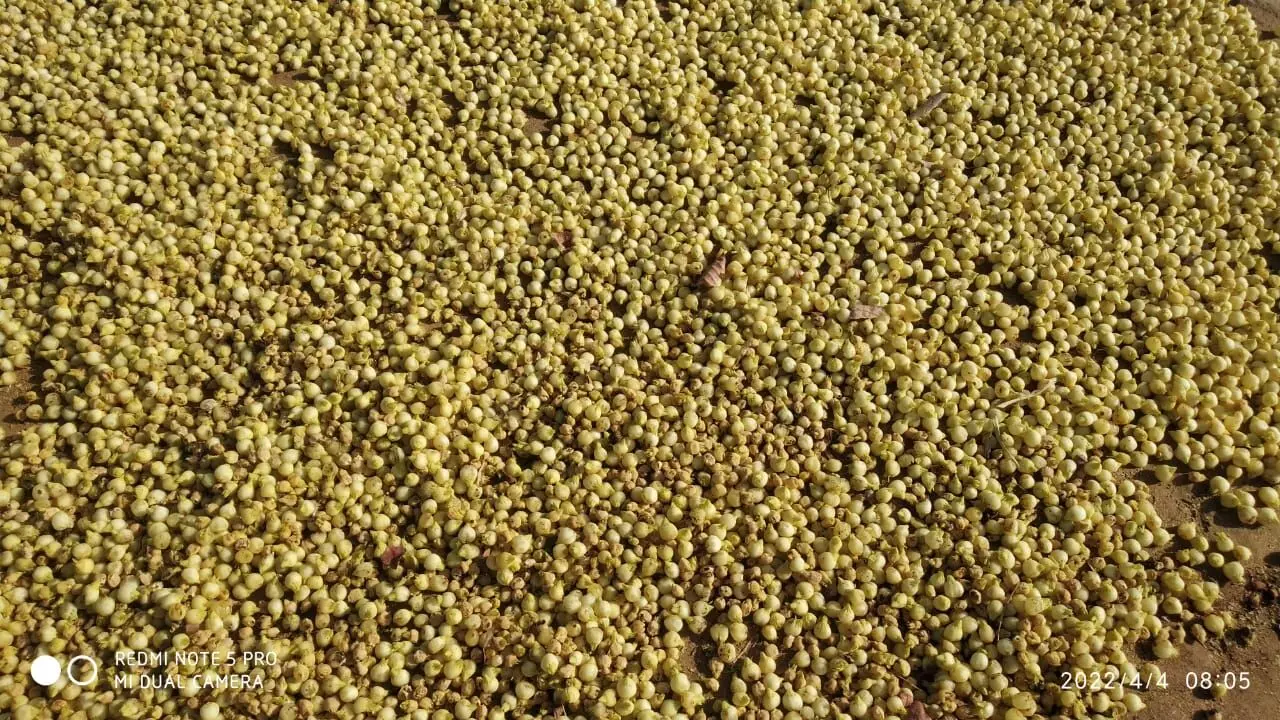
Photo by: Arun Singh
“It has been a good season,” smiled Deeprani from Vikrampur, who was out collecting flowers with her nine-year-old son, Basant. “We have about twenty seven mahua trees in our fourteen acres of land and I know we will get at least six to seven quintals of flowers from it,” the 36-year-old said happily to Gaon Connection.
The importance of mahua is highlighted in a 2018 research paper, Economic Impact of Mahua (Madhuca spp.) on Tribal Livelihood and It`s Marketing In Chhattisgarh State, which notes :farmers are not cultivating the Mahua but making profit out of it by collecting them and selling into the market either directly to the consumers or through the mediators at different levels”.
Sale and marketing of mahua
Meanwhile, Kalda Rampur, which falls in the south forest division of Panna, wears a festive look with its mahua trees with their heavily laden flowers. The fragrance of the flowers is everywhere and the entire Adivasi population seems to have come out to pick flowers.
According to the tribal communities in Kalda Pathar, tradespeople from Amdara, Maihar, Pawai and Saleha come to the village to buy the flowers from them.
According to data from the Minor Forest Produce Co-operative Federation, south forest division in Panna, nearly 3,000 quintals of flowers are harvested from villages including Kalda, Rampur, Mainha, Pipriya, Jaitupura, Tokulpondi, Bhopar, Shyamgiri, Kusmi, Jhiriya and Dondi.

Photo by: Arun Singh
In Umaria district in Madhya Pradesh, mahua flowers come under the One District One Product scheme.
Nearly 17,000 tonnes of mahua are produced in the district, annually. The livelihood mission has taken it upon itself to train the people in the right way to collect the flowers in order to safeguard their quality. of the flowers found in the district.
The livelihood mission has distributed nets to collect the mahua flowers in Umariya. The nets are spread out on the ground so that they protect the flowers when they fall from the branches.
Going by the information from the state’s Minor Forest Produce Co-operative Federation, more than 75,000 quintals of flowers are bought from the adivasis.
Mahua MSP
In order to benefit the forest dwellers, forest minister of the state, Kunwar Vijay Shah said that a minimum support price (MSP) was fixed for 32 minor forest produce in Madhya Pradesh. The MSP for mahua flowers has been fixed at Rs 35 a kg.
There are 179 purchase centres and 47 godowns to store the minor forest produce collected across the state.
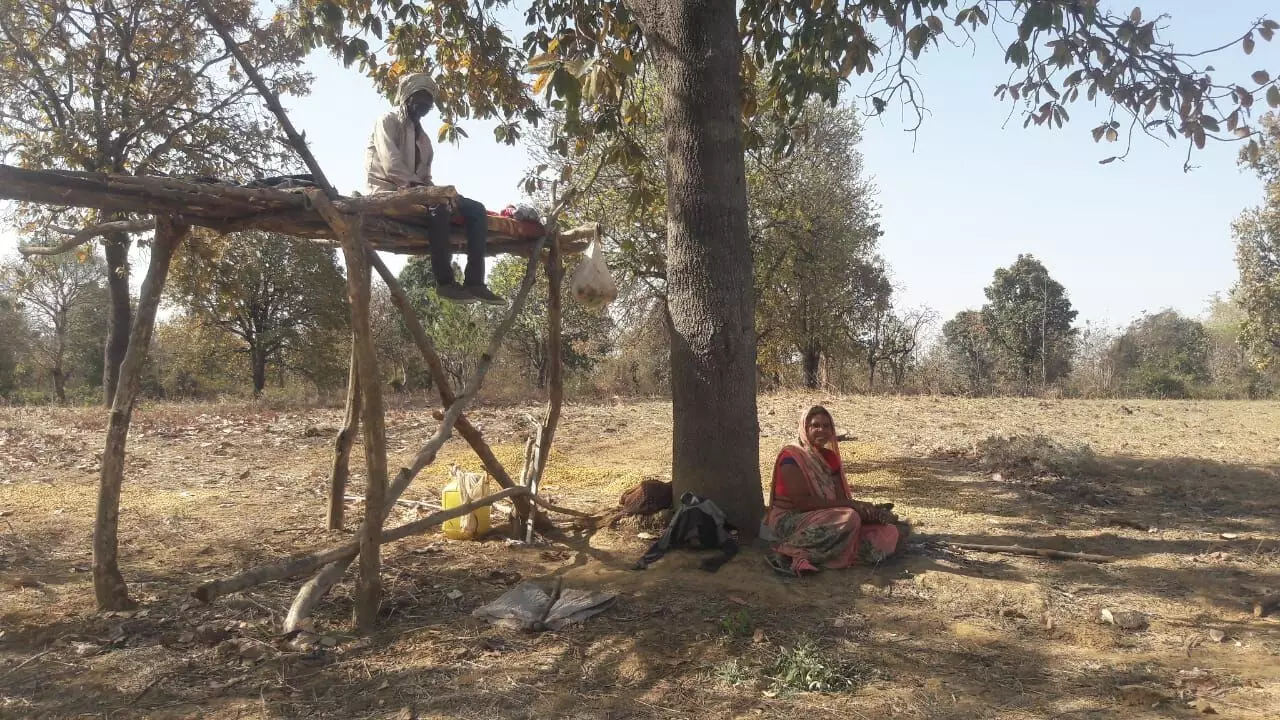
Photo by: Arun Singh
Under the prime minister’s Van Dhan Vikas Yojana scheme, an initiative of the Ministry of Tribal Affairs and TRIFED, an attempt will be made to improve tribal incomes through value addition of tribal products. Under the scheme there are 107 Van Dhan kendras or centres across 19 districts.
The MSP of Rs 35 a kilo is much less than what the flowers actually go for. “Traders come to our villages and pick up flowers for at least forty five rupees a kilo,” Pratipal Singh of Vikrampur told Gaon Connection. “In another couple of months the price will further rise to nearly sixty rupees a kilo,” he added.
“Because of the low MSP, barely 15 to 20 per cent of the flowers are procured by the government,” Gyanendra Tiwari of Samarthan, said.







